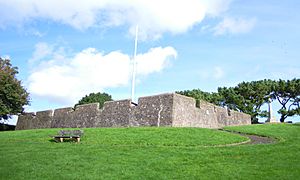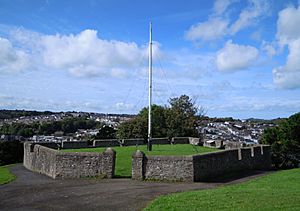Chudleigh Fort facts for kids
Quick facts for kids Chudleigh Fort |
|
|---|---|
 |
|
| Type | Artillery battery folly |
| Location | East-the-Water |
| Nearest city | Bideford, Devon |
| Founded | August 1642 |
| Founder | Sir George Chudleigh James Chudleigh |
| Built for | Parliamentarian forces |
| Original use | English Civil War gun platform |
| Restored | Mid 19th Century |
| Restored by | James Ley |
| Owner | Torridge District Council |
| Type | Grade II |
| Designated | 8 November 1949 |
| Lua error in Module:Location_map at line 420: attempt to index field 'wikibase' (a nil value). | |
Chudleigh Fort is a unique, decorative fort located in East-the-Water, a part of Bideford in Devon, UK. It stands on the spot where a real military fort was built way back in the 1600s. This original fort was used during the English Civil War. Later, in the 1800s, the fort was rebuilt in stone to be a beautiful viewpoint, not for fighting. Today, it's a special historic building, protected since 1949.
Contents
Chudleigh Fort: A Look Back at Its Beginnings
The first fort on this site was built for an important landowner named Sir George Chudleigh and his son, James Chudleigh. James was a soldier who had fought in Ireland.
Why the Chudleighs Chose a Side
During the English Civil War, the Chudleighs decided to support the Parliament's side. This was different from many powerful families who sided with King Charles I. They felt the King was unfair to merchants, especially with a tax called "ship money." This tax made it harder for important trading towns like Bideford and Barnstaple to do business.
Building the First Forts
Around August 1642, James Chudleigh built two special areas for cannons. These were called "gun platforms" and were made of earth. Each platform could hold eight cannons. They were placed on high ground on both sides of the River Torridge. Their job was to protect Bideford from attacks by ships belonging to the King's army.
The Siege of Bideford
By the summer of 1643, the King's army was winning many battles in the South West of England. Parliament's forces had to retreat into Bideford. Soon, Bideford was surrounded by the King's army, a situation called a "siege." In August 1643, after fierce fighting around the two forts, the town of Bideford fell to the King's forces. James Chudleigh was not in Bideford during this time; he was fighting in another battle.
After the War
Once the Civil War ended, these forts were no longer needed and were left empty. The fort on the west side of the river was eventually covered by new buildings as Bideford grew. However, the fort on the hill at East-the-Water remained untouched for many years.
Chudleigh Fort: From War to Wonder
In the mid-1800s, the old gun platform at East-the-Water was rebuilt. A man named James Ley from Northam turned it into a stone "folly." A folly is a building made to look interesting or beautiful, not for a real purpose like defense.
A Fort for Fun
James Ley's new fort was five-sided and had 14 places for cannons, even more than the original eight. He even put seven old cannons on wooden wheels inside. But this new fort was never meant for real battles. Its stone walls were too thin, and the back was open, so it couldn't really defend anything.
There's a plaque on the wall that says the fort was built in April 1642. However, this is a small mistake, as the Civil War didn't officially start until August 1642.
A Park for Everyone
In 1921, people bought the fort's land together to create a public park. This park was made to remember those who died in World War I. A war memorial was built, paths were added, and the park was landscaped with grass. Later, the memorial was updated to honor those from Bideford who died or went missing in both World War I and World War II. Today, the Torridge District Council takes care of the park for everyone to enjoy.



